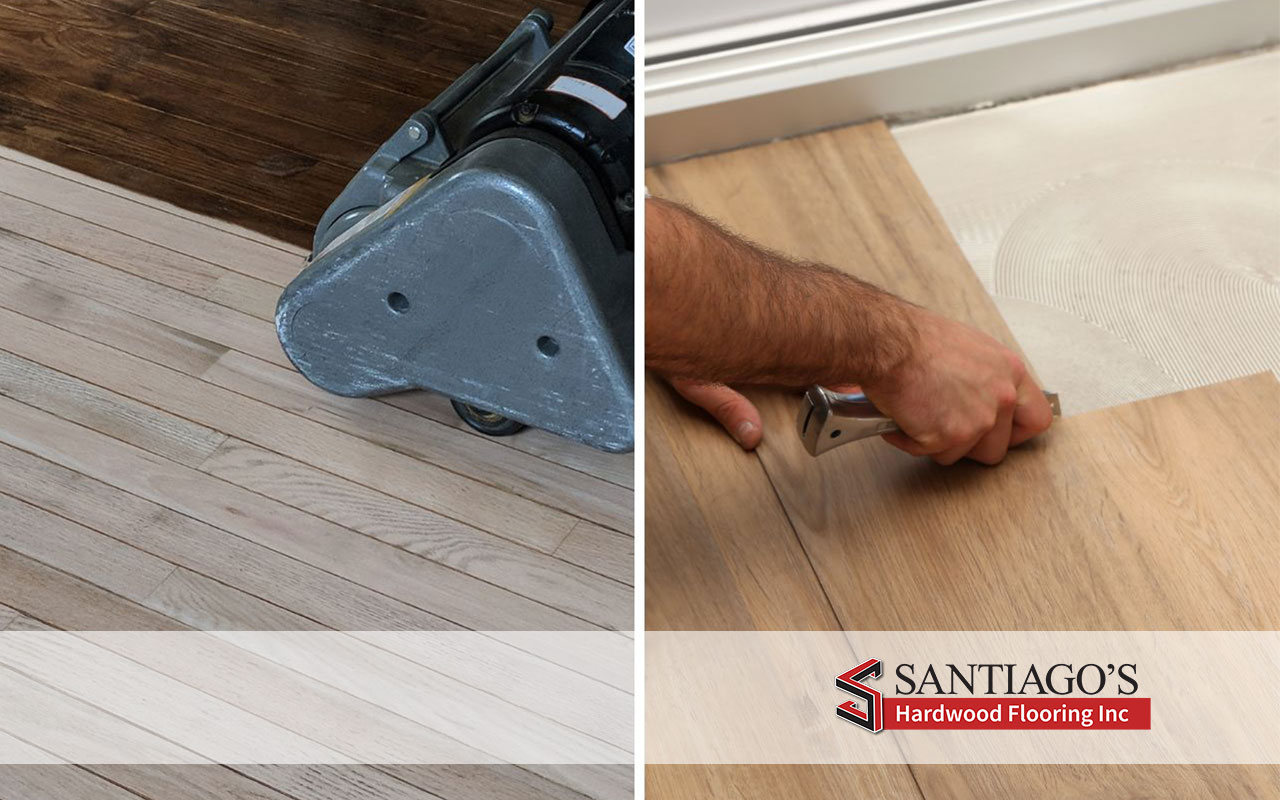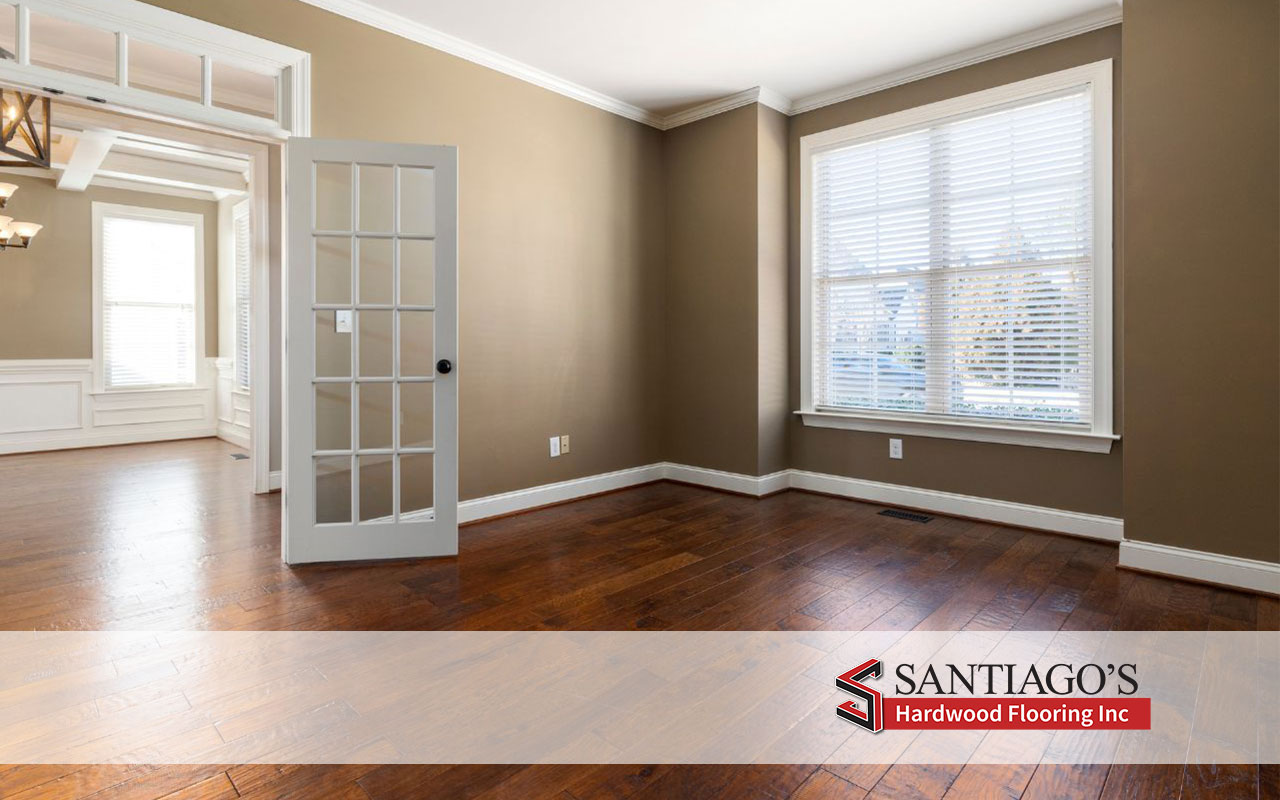
In this Article:
Weighing the Options: Should You Refinish or Replace Hardwood Floors?
Navigating through the Dilemma: Strategies to Effectively Refinish or Replace Hardwood Floors
The Art and Science of Refinishing
Embracing a Fresh Start with Replacement
Cost-Benefit Analysis in Decision Making
Aesthetic and Future-Proofing Your Floors
Embarking on the Journey: Tips and Considerations When You Refinish or Replace Hardwood Floors
Tips for Successful Hardwood Floor Refinishing
Making Replacement a Smooth Transition
Ensuring Excellence with Santiago’s Hardwood Flooring Inc. – Your Trusted Partner in Floor Solutions
In the robust world of home improvement, homeowners frequently find themselves entangled in decision-making dilemmas, especially when it comes to maintaining the aesthetic and functionality of their spaces. Deciding whether to refinish or replace hardwood floors tends to be a predominant query, given the significant role that flooring plays in defining the character of our homes.
Striking a balance between preserving the antique charm of aged hardwood and ensuring structural integrity becomes pivotal. This guide seeks to shed light on the various aspects of this vital decision, considering factors like cost, time, and end-result aesthetic, aiming to assist you in making an informed choice between refinishing your treasured hardwood flooring or opting for a fresh, invigorating replacement.
Weighing the Options: Should You Refinish or Replace Hardwood Floors?

Embarking on the journey to refinish or replace hardwood floors sets forth an array of considerations beyond mere visual appeal. The character of hardwood, with its innate durability and timeless elegance, commands attention in any space it adorns.
When wear and tear start to unveil themselves, homeowners are met with the essential query: to uphold the existing charm through refinishing or to innovate with a comprehensive replacement. Each pathway offers unique benefits and drawbacks, intertwining aspects like budget, sustainability, and desired aesthetic outcomes into the decision-making process. In this segment, we will delve deep into both options, presenting a panoramic view of what each choice may bring to your dwelling space.
Navigating through the Dilemma: Strategies to Effectively Refinish or Replace Hardwood Floors
Identifying the Signs of Wear
Hardwood floors are notably resilient, but over time, they inevitably exhibit signs of wear and tear. Noticing discoloration, deep scratches, or structural damages should prompt homeowners to evaluate whether to refinish or replace hardwood floors. A crucial distinction lies in understanding superficial blemishes, which can be revitalized through refinishing, and acknowledging when damage suggests a need for replacement.
The Art and Science of Refinishing
Refinishing hardwood floors involves sanding down the current surface and reapplying a finish to rejuvenate its appearance and durability. It’s a viable option when the wood is still structurally sound and only the top layer has suffered.
This approach is typically less costly and more environmentally friendly than replacement, preserving the existing wood and retaining the home’s authentic character.
Embracing a Fresh Start with Replacement
Choosing to replace hardwood floors often comes into play when significant damage, such as warping or cracking, has been refinished multiple times. Replacement allows you to explore new types, colors, and flooring patterns, offering a fresh aesthetic and a chance to incorporate modern, durable materials.
Cost-Benefit Analysis in Decision Making
It’s imperative to weigh the costs and anticipated benefits when deciding whether to refinish or replace. Refinishing is usually lighter on the pocket and less disruptive. At the same time, a replacement can be a sizable investment, providing your space with a new look and feel.
Time and Convenience Factors
Time and convenience factor into the decision significantly. Refinishing usually demands a few days and can be relatively mess-free with the right professionals. In contrast, replacement could span weeks and involve more intensive labor, temporarily affecting your day-to-day living conditions.
Aesthetic and Future-Proofing Your Floors
While maintaining the age-old authenticity of hardwood is enchanting, incorporating modern hardwood replacements could offer better durability and a refreshed aesthetic. It’s also an opportunity to install hardwood that aligns with contemporary design trends, potentially elevating the property’s value and future marketability.
Engaging in the debate to refinish or replace hardwood floors implicates considering various aspects, all of which converge towards enhancing your home’s aesthetic, functionality, and value.
Both paths offer unique advantages and involve particular considerations, which, when meticulously assessed, guide homeowners toward a decision that resonates with their preferences, budget, and long-term plans.
Embarking on the Journey: Tips and Considerations When You Refinish or Replace Hardwood Floors
Tips for Successful Hardwood Floor Refinishing
Refinishing hardwood floors can breathe new life into your space, revealing the hidden beauty beneath years of wear. Consider the following tips to ensure a successful refurbishment:
Choosing the Right Finish: Depending on the desired sheen and durability, opt between oil-based, water-based, or natural oil finishes.
Employing Professionals: Expertise prevents unintended damages during the sanding and finishing process.
Managing Dust: Ensure your service provider takes meticulous precautions to manage dust and maintain indoor air quality.
Making Replacement a Smooth Transition
A hardwood floor replacement should be seamless and align with your living space aesthetics. Keep in mind:
Material Selection: Choose a hardwood that compliments your living spaces and is in harmony with your decor.
Budget Management: Keep a keen eye on your budget, considering material and installation costs.
Installation Timeline: Plan your replacement during a timeframe that minimally disrupts your daily life and routines.
Unearthing the Hidden Costs
Whether you decide to refinish or replace hardwood floors, be prepared for hidden costs:
Refinishing: Additional costs might stem from repairing damaged areas before refinishing begins.
Replacement: Beyond the apparent costs, floor removal, subfloor preparation, and disposal can add to your budget.
Frequently Asked Questions
How often can hardwood floors be refinished?
Generally, hardwood floors can be refinished several times during their lifespan, depending on the wood’s thickness and quality.
How long does it take to replace hardwood floors?
Replacement timelines vary based on room size, type of hardwood, and specific installation processes.
Can damaged hardwood floors be refinished?
If the damage is superficial, yes. However, structural damages often necessitate replacement.
Every journey towards revitalizing or redefining your space through hardwood floors necessitates thorough consideration and planning. Whether you unveil the concealed charm beneath the worn-out surface or decide to innovate with a fresh start, both pathways are embarked towards preserving and elevating the essence of your living spaces.
Ensuring Excellence with Santiago’s Hardwood Flooring Inc. – Your Trusted Partner in Floor Solutions

Navigating through the layered considerations of whether to refinish or replace hardwood floors can be a daunting expedition. However, with Santiago’s Hardwood Flooring Inc, this journey transfigures into a harmonious blend of quality, assurance, and aesthetic brilliance.
We offer professional hardwood flooring services! We stand as your unwavering ally in crafting spaces that resonate with beauty, durability, and timeless charm.
Embark on a journey where every step is a statement of style and quality. Allow us to be the architects of your flooring dreams. Connect with us, and let’s build the foundation of your exquisite spaces, one plank at a time.
